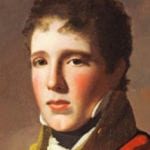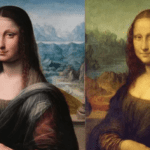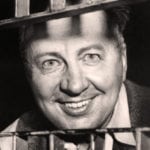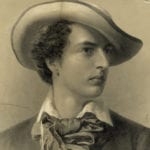 Technology
Technology  Technology
Technology  Humans
Humans 10 Everyday Human Behaviors That Are Actually Survival Instincts
 Animals
Animals 10 Animals That Humiliated and Harmed Historical Leaders
 History
History 10 Most Influential Protests in Modern History
 Creepy
Creepy 10 More Representations of Death from Myth, Legend, and Folktale
 Technology
Technology 10 Scientific Breakthroughs of 2025 That’ll Change Everything
 Our World
Our World 10 Ways Icelandic Culture Makes Other Countries Look Boring
 Misconceptions
Misconceptions 10 Common Misconceptions About the Victorian Era
 Mysteries
Mysteries 10 Strange Unexplained Mysteries of 2025
 Miscellaneous
Miscellaneous 10 of History’s Most Bell-Ringing Finishing Moves
 Technology
Technology Top 10 Everyday Tech Buzzwords That Hide a Darker Past
 Humans
Humans 10 Everyday Human Behaviors That Are Actually Survival Instincts
 Animals
Animals 10 Animals That Humiliated and Harmed Historical Leaders
Who's Behind Listverse?

Jamie Frater
Head Editor
Jamie founded Listverse due to an insatiable desire to share fascinating, obscure, and bizarre facts. He has been a guest speaker on numerous national radio and television stations and is a five time published author.
More About Us History
History 10 Most Influential Protests in Modern History
 Creepy
Creepy 10 More Representations of Death from Myth, Legend, and Folktale
 Technology
Technology 10 Scientific Breakthroughs of 2025 That’ll Change Everything
 Our World
Our World 10 Ways Icelandic Culture Makes Other Countries Look Boring
 Misconceptions
Misconceptions 10 Common Misconceptions About the Victorian Era
 Mysteries
Mysteries 10 Strange Unexplained Mysteries of 2025
 Miscellaneous
Miscellaneous 10 of History’s Most Bell-Ringing Finishing Moves
15 Most Influential Jazz Artists
As one of the most well-respected American art forms, jazz has shaped the music industry, spawning both the careers of various musical geniuses and an abundance of elemental new music genres. Jazz was developed in the late 19th century and early 20th century as American and European classical music was mixed with African and slave folk songs. These songs were played to a syncopated rhythm, and from this emerged ragtime, then Dixieland, and subsequently Big Band, what many consider to be the beginning of modern jazz. There is obvious West African influence, visible in terms of how the music is written and played; swing rhythm, polyrhythm, improvisation, and syncopation are all prominent examples that are almost exclusively characteristics of jazz music.
Over the course of the 20th century, this art form has been changing drastically as new artists bring on new influence and new sound. Dixieland became big-band, which became be-bop, which became fusion, Latin, and free jazz, which, in turn, established their own separate styles like funk, acid-jazz, hard-bop, smooth jazz, cool jazz, etc. The musicians behind this ever-growing phenomenon are recognized as some of the best musicians of all time. Compiled here are who I believe are the best of the best and the most influential throughout the history of jazz music.
Perhaps the best-known jazz trombonist of all time, J.J. Johnson was the first one of the earliest musicians on the instrument to play in the bebop style. Born in 1924, his career started (as with most jazz artists from that era) in the 40s swinging big bands and orchestras – most notably Benny Carter and Count Basie. However, in the mid-40s, he was spurred on by trumpeter Dizzy Gillespie to embrace the new bebop style. The 1950s saw him make his first Blue Note albums—both as a bandleader and with Miles Davis. After a hiatus from playing that started in the 1960s (he moved to Hollywood to write for film and television), he returned to touring and was turning out critically acclaimed recordings well into the mid-90s.
Some of the most complex and dissonant harmonies can be found in the repertoire of pianist and composer Thelonious Monk, one of the most important contributors to bebop music. His somewhat eccentric persona also helped popularize jazz. Known for his “hip” style in suits, hats, and sunglasses, Monk, in essence, personified the uniqueness and idiosyncrasy that was his music. His novel, improvisational approach helped to create a plethora of jazz standards like “Epistrophy,” “Blue Monk,” “Straight, No Chaser,” “I Mean You,” and “Well, You Needn’t.” Monk’s style was commonly characterized by his innovative approach to piano playing, including percussive attacks and abrupt pauses. He often got up from the piano during performances and danced a bit while the other band members continued playing. Thelonious Monk remains one of the most celebrated and renowned pianists in any genre.
An acclaimed bass virtuoso, composer, bandleader, and occasional pianist, Charles Mingus was one of the most creative musicians in the jazz scene. He developed a completely unique style, embracing elements of gospel, hard bop, free jazz, and classical music. Mingus was called the “heir apparent to Duke Ellington” because of his fantastic writing for medium-sized ensembles. His compositions showcased the skill of each of his players, whom he made sure were not only talented but characteristically unique like himself. Mingus was feared for his temper, both on and offstage. He once punched trombonist Jimmy Knepper in the face, breaking off a crowned tooth and essentially ruining Knepper’s embouchure. Mingus suffered from clinical depression and refused to compromise his musical integrity, which resulted in on-stage eruptions and often the threatening of other bandmates. Despite this, Mingus is one of the most important figures in bebop, bass, and jazz history.
Art Blakey was a famous American drummer and bandleader who revolutionized the way jazz drums were played. His unique approach to drumming incorporated bits of swing, blues, funk, and hard bop, a style that is heard today in drummers everywhere. Along with Max Roach and Kenny Clarke, he is considered to have invented the modern bebop style of drumming. For over 30 years, his band The Jazz Messengers launched the careers of a multitude of famous jazz artists, like Benny Golson, Wayne Shorter, Clifford Brown, Curtis Fuller, Horace Silver, Freddie Hubbard, Keith Jarrett, Wynton Marsalis, and countless others. The Jazz Messengers produced phenomenal music and served as a proving ground of sorts for young musicians, similar to Miles Davis’s band. Art Blakey’s style changed the way jazz sounded and the way drums were played in modern bebop.
American jazz trumpet player, singer, composer and bandleader, Gillespie was very significant in the development of bebop and modern jazz. His trumpet playing influenced such players as Miles Davis, Clifford Brown, and Fats Navarro. After spending time in Cuba and coming back to America, Gillespie also greatly helped advance Afro-Cuban Jazz. He was characterized by his horn-rimmed glasses, bent trumpet, and uniquely puffy cheeks when playing. A great improviser, Dizzy added a certain layer of harmonic complexity to his music, something previously unknown in jazz. Songs like “Salt Peanuts” and “Groovin’ High” were very different, both harmonically and rhythmically, when compared with the sounds of his contemporaries. Remaining true to bebop his entire career, Gillespie is remembered as one of the most influential trumpet players in history.
Max Roach is considered one of the greatest drummers in history and was a renowned bebop pioneer. He is, along with a select few, essentially responsible for the modern style of jazz drumming. Roach was also involved greatly in the Civil Rights movement, creating an album with Oscar Brown Jr. and Coleman Hawkins called “We Insist! – Freedom Now,” commemorating the 100th anniversary of the signing of the Emancipation Proclamation. Roach performed with amazing style, able to play entire shows solo, showing that, given his incredible skill, he could play and completely satisfy an entire audience while fulfilling the requirements of a solo performance. Roach, completely in tune with the bebop scene, played with artists like Clifford Brown, Miles Davis, Charlie Parker, Dizzy Gillespie, Duke Ellington, and Charles Mingus, ensuring a vibrant and successful career.
“Lady Day” was perhaps the most exceptional popular music singer of the 20th century. She wrote few songs, but she took on a deep, personal, and intimate approach when she sang. Her vocal style and intonation were inspired greatly by the instruments she heard and was filled with a profound intensity. In that manner, she developed a new style, incorporating the manipulation of phrasing and tempo. Her recording of the song “Strange Fruit” is considered one of the most important songs in history because of its powerful theme and topic and Holiday’s powerful performance. She received multiple posthumous Grammy Hall of Fame awards and Grammy Best Historic Album awards for her work. Although her delivery may have been somewhat thin and her range fairly limited, there is no doubt that her voice was more powerful than any at the time could have hoped to be.
John Coltrane is virtually synonymous with the word “cool.” At the forefront of hard bop, Coltrane, a composer and saxophone virtuoso, made serious headway into becoming one of the most important figures in jazz music. Coltrane had a harsh, strident sound and played with extreme intensity. He was able to solo and improvise with astounding power, creating “sheets of sound.” Playing tenor and soprano sax, Coltrane could either play with a smooth melodic sound or an unmatched intensity. His compositions, along with Miles Davis, helped redefine be-bop with the introduction of modal harmony and the “Coltrane Changes.” Coltrane, a figurehead of avant-garde jazz, was also prolific in his recordings, making about 50 albums in his career as a bandleader. He has been recognized extensively, with an induction in the Downbeat Jazz Hall of Fame, a Grammy Lifetime Achievement Award, a Grammy for “Best Jazz Solo Performance,” and a church that worships him as a saint.
Groundbreaking pianist, organist, composer, and bandleader Count Basie led one of the most successful bands in history. For 50 years, the Count Basie Orchestra, an incredibly popular group of musicians who included players like Lester Young, Sweets Edison, Buck Clayton, and Joe Williams, maintained one of the most swingin’ and hard-hittin’ bands in America. Winner of nine Grammy awards, Basie introduced multiple generations of listeners to the big band sound. He wrote numerous standards like “April in Paris” and “One O’Clock Jump,” which, for years, have been covered by countless other artists. His colleagues also remember Basie as being considerate, modest, relaxed, and enthusiastic. Without Basie’s crucial presence on the scene, popular and big band music would be drastically different and undoubtedly less influential than it has become.
The tenor saxophone is iconic of bebop and jazz music in general, and there is one person accountable for this: Coleman Hawkins. Hawkins’s innovation in swing and big band music was vital in the development of bebop in the mid-1940s. His contribution to the saxophone made the careers of people like John Coltrane, Sonny Rollins, and Dexter Gordon possible. Hawkins’s original recording of “Body and Soul” in 1939 is considered a standard to which all tenor saxophonists set themselves. People like Thelonious Monk, Miles Davis, and Max Roach can essentially attribute their successful careers to their early work with the “Hawk.” His ability to improvise led him to cover completely new ground, previously untouched by his contemporaries; it is because of this that the tenor sax is now such an important improvisational element of jazz music.
Few can match the swingin’ sounds of Goodman’s Big Band. Benny Goodman, known as the “King of Swing,” led one of the most popular bands of the early 20th century. His 1938 concert at Carnegie Hall is considered one of the most important live shows in American music history, as it showcased jazz’s coming to prominence as a respectable art form. Despite being a major player of big-band swing music, Goodman also helped the advancement of be-bop. Having one of the first racially integrated music groups and being a strong opposer of Jim Crow Laws, Goodman promoted racial equality by not touring the Southern States. Goodman was both an important influence in popular and jazz music and a prominent Civil Rights activist.
One of the central figures of jazz in the 20th century, Miles Davis, was at the forefront of multiple musical developments and the emergence of a plenitude of styles. He spearheaded the emergence of bebop, hard bop, cool jazz, free jazz, fusion, funk, and techno music. Keeping ahead of the game and consistently reinventing his musical style, the various lineups of his band, all of which were very successful, were always full of young brilliant players. Because of his success, many other artists were propelled to high levels of fame. Some famous jazz artists who owe their success to Miles include John Coltrane, Herbie Hancock, J.J. Johnson, Cannonball Adderley, Keith Jarrett, Bill Evans, Wayne Shorter, and Chick Corea. Davis received various rewards in his lifetime, including eight Grammy Awards and a Rock and Roll Hall of Fame induction. Miles Davis was one of the best, most innovative, popular, and influential musicians of the 20th Century.
When one thinks of jazz, they think “Charlie Parker.” Known simply as “Bird,” Charlie Parker was a pioneering jazz alto-saxophone player, bebop musician, and composer. His fast, virtuosic playing, clean tone, and improvisational abilities greatly influenced other musicians at the time. His innovation in writing songs, using complex chord progressions and revolutionary harmonic form, changed the standards for composition and greatly influenced other jazz artists. Parker helped to contribute to the hipster persona associated with jazz and the idea that jazz musicians were artists and intellectuals rather than simply entertainers. At the time, many other artists tried to copy Parker’s style, and often his solos and licks exactly. His influence is seen in almost every other contemporary musician and renowned jazz composer, many of whom named some choice standards after the “Bird.”
Duke Ellington was a hugely popular pianist, composer, and big-band leader. He was one of the most important bandleaders in music. Although known for his pioneering in jazz, Ellington also excelled in various other genres, including gospel, blues, classical, popular, and soundtrack. Because of his charisma and inventive use of his orchestra, Ellington is essentially responsible for making jazz an art form, similar to classical music. He received various awards and honors, including 13 Grammy awards, a Pulitzer Prize, a Presidential Medal of Freedom, an NAACP Spingarn Medal, and a Commemorative U.S. quarter, to name a few. A considerable amount of musicians have been inspired by the “Duke,” including Thelonius Monk, Sonny Stitt, Tony Bennett, Dizzy Gillespie, Oscar Peterson, Earl Hines, and Joe Pass, as Ellington has proved to be one of the most important figures in jazz and music in general.
Arguably one of the most important figures in American history, Louis Armstong, known as “Satchmo” or “Pops,” was an incredibly influential jazz trumpet player and singer from New Orleans. He is recognized as one of the greatest musicians of all time, having a major role in creating modern jazz. With his virtuosic abilities on the trumpet, he is largely accountable for recognizing the trumpet as a solo instrument in jazz music. He is also one of the first scat singers and is responsible for its popularization. His singing influenced people like Frank Sinatra and Bing Crosby, while his trumpet playing inspired the likes of Miles Davis and Dizzy Gillespie. His influence on music as a whole is almost immeasurable, both in terms of his singing and trumpet playing, which have earned him various honors and awards.
Notable Exclusions: J.J. Johnson, Wes Montgomery, Django Reinhardt, Ron Carter, Ella Fitzgerald, Paul Chambers, Elvin Jones, Herbie Hancock, Lester Young, Ray Brown, Gene Krupa, Frank Sinatra, Dave Brubeck, Freddie Hubbard, Earl Hines, Buddy Rich, Bill Evans, Red Garland, Clifford Brown, Dexter Gordon, Sonny Rollins, and Oscar Peterson.








